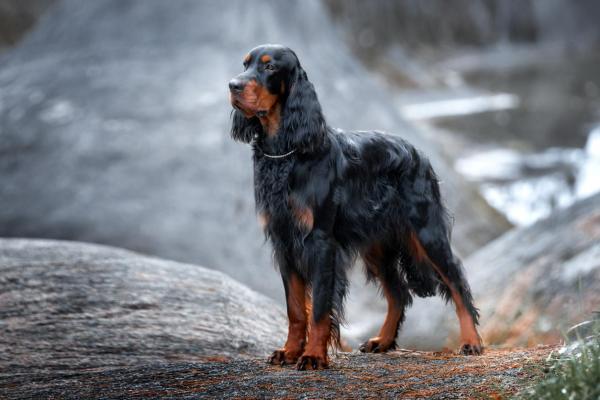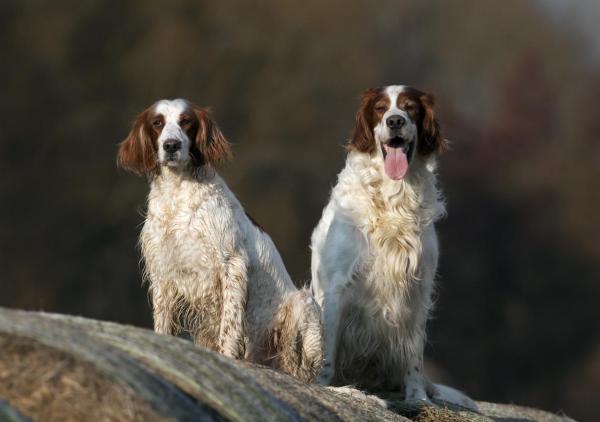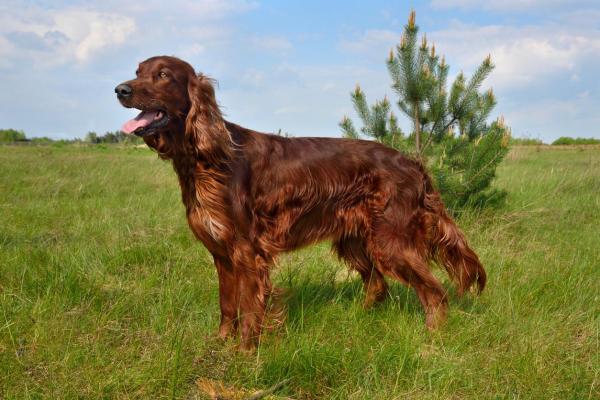
Since breeds of domestic dog are always evolving, they can be difficult to categorize. This is why some types of dog breed are grouped together in sub-categories. Such is the case with Setter dog breeds, a sub-category of gundog. There are four types of dog recognized as Setters: English Setter, Gordon Setter, Irish Setter and Irish Red and White Setter. In our AnimalWised article, we bring you information on these different Setter dog breed types and provide photos so you can recognize one when you see them.
General characteristics of setter dogs
As Setters are types of gundog, they are known for their hunting skills. More specifically, they are pointing dogs. We recognize pointing dogs by the characteristic stance they make when they spot potential prey. This alerts their human counterparts in search of game.
Setters are generally considered very intelligent and noble dogs, but they also have an affectionate nature. This makes them both ideal as a working dog or companion animal. However, they are also known to be somewhat stubborn in temperament, so they will need to be well educated to ensure proper conduct.
Physically, Setters are elegant dogs with an athletic body shape. They carry their heads high when moving and are able to use their hind limbs for quick propulsion. Their size is fairly consistent even between the different breeds. Males have a height at the withers of about 52-68 cm and females measure around 57-65 cm. Their weight ranges from around 20-32 kg (44-70 lbs).
Some other characteristics consistent in all Setter breed types are dar colored eyes, low-set ears which fall on both sides of the head and a long muscular neck. They also have a chest which is narrow, but deep, and ribs which can usually be seen through their skin. Setters tend to have long fur on the ears, belly, back of legs and tail. Their hair can be either straight or wavy, depending on the breed. The coat color will vary according to the type of Setter.
English Setter
This Setter breed is native to Great Britain and dates back to the 15th Century. It is the most common Setter type dog breed.
This dog has a very friendly and affable character. They are a very active breed with a keen hunting sense. In terms of size, males measure between 65-68 cm at the withers and females measure 61-65 cm. Their elegance can be seen in their movement as much as their sleek body shape. Speed, strength and endurance are also notable physical traits.
English Setter breed standards describe the following:
- Head: a well-defined stop with a frontonasal junction. Their nose (nose) should be black or liver in color, depending on the color of their coat. The muzzle is quite square. They have bright eyes, with a sweet and expressive look. Eye can vary from hazelnut to dark brown, with dark colors being the most valued in the official breed standard. The ears are medium in size and hang on both sides of the face. They are covered with fine silky hair at the base and are velvety at the tip. Males have a slightly thinner head than females.
- Body: The neck is long, muscular and slightly arched. It ends in a deep chest with well arched ribs.
- Tail: of medium length (does not reach the height of the hocks) and has long, hanging fringes that gradually decrease in length until they reach the tip.
- Coat: the hair is long and slightly wavy, but never curly. The back of the fore and hind legs are fringed, as is the tail.
The coat of English Setters often has a speckled coat which is known as ‘belton’ in this breed. The most common English Setter coat colors are:
- Blue belton: black and white
- Orange belton: orange and white
- Lemon belton: lemon and white
- Liver belton: liver and white
- Tricolor: blue belton and tan or liver belton and tan
If you want to know more about the differences between certain dog breeds, check out our related article on the different Collie dog breeds and types.

Gordon setter
Staying in Great Britain, but moving further north, the Gordon Setter originates in 17th Century Scotland. Conversely, they are the least common Setter dog breed type, but they are also noted for their intelligence and nobility. Their character is affable and stable, but they stand out for their excellent swimming ability.
Gordon Setters are smaller than most other Setter breeds. Males measure up to 66 cm at the withers and females measure about 62 cm. Males average 29.5 kg (65 lbs) in weight and females weigh around 25.5 kg (56 lbs). As with English Setters, the Gordon Setter has a graceful appearance and are built for speed.
Gordon Setter breed standards describe the following:
- Head: they have a clearly defined stop. The nose truffle of a Gordon Setter is always black. Their eyes are bright and dark brown, with a cunning and intelligent expression. The ears are also medium in size and hang on both sides of the head.
- Body: the neck is long, thin and arched. The chest is deep, but not very wide.
- Tail: medium in size and does not exceed the hock line. It is straight and is usually carried horizontally or below the line of the back. It has fringed hair at the base which decrease as it reaches the tip.
- Coat: hair is straight (without waves or curls), short on the head and forelimbs and of medium length on the rest of the body.
- Color: coat color is deep and shiny black with spots of tan. They may have black spots on the digits and black streaks in the jaw area.

Red and White Irish Setter
As the name suggests, the Red and White Irish Setter originates in Ireland, also during the 17th Century. Today it is much less common than the Irish Red Setter. They are dogs with a cunning and intelligent character, in which determination and courage prevail. They are characterized by being especially friendly and easy to train as hunting dogs.
The size is slightly smaller than that of the English Setter. Males have a height at the withers of 62-66 cm and females of 57-61 cm. Its general appearance is strong, well balanced and proportionate, being more athletic than light. When trotting, they have a lively and graceful movement.
Red and White Irish Setter breed standards describe the following:
- Head: the muzzle is quite square and the stop is marked. The eyes are dark hazel or dark brown and the ears fall back close to the head.
- Body: neck is moderately long, very muscular and slightly arched. It ends in a deep chest with well-arched ribs. The body and limbs are especially strong and muscular .
- Tail: the tail does not descend beyond the hock and is usually carried at the level of the back or below.
- Coat: their hair is long and forms characteristic fringes on the back of the fore and hind legs, ears, flanks and tail. On the rest of the body, the hair should be short and straight.
- Color: base color is white and has solid red patches (like well-defined islands). Only spots are allowed, not speckled or ‘belton’ as in the English Setter.
For more information on another type of dog breed, take a look at our article on types of Doberman Pinscher.

Irish Red Setter
The last of the setter dog breeds we describe here originated in Ireland in the 18th century. The reason we put the Red and White Irish Setter first, is because the Irish Red Setter (commonly known simply as the Red Setter) descends from the Red and White Irish Setter. This was carried out by a process of selected breeding which erased the white hairs of the coat. Today the Irish Red Setter predominates as a breed.
Over the years the Red Setter has evolved into a dog with great vigor and capacity for work. It is characterized by being a cunning, intelligent, energetic, affectionate and loyal breed. Their movement is fluid and energetic.
The size range is more variable than in the Red and White Irish Setter. Males have a height at the withers of between 58-67 cm and females between 55-62 cm. Like its red and white ancestor, it has a balanced and well-proportioned appearance.
Irish Red Setter breed standards describe the following:
- Head: the muzzle is almost square and the stop is well defined. The nose is mahogany, dark walnut or black in color. The eyes are dark hazel or dark brown. The ears are medium in size and fall back on both sides of the head.
- Body: the neck is very similar to that of the Red and White Irish Setter as it is moderately long, very muscular and somewhat arched. It ends in a deep, but rather narrow chest with well arched ribs.
- Tail: the tail is medium in size and carried at the level of the back line or lower.
- Coat: the hair is short on the head, front of the limbs and tips of the ears. On the rest of the body it is of medium length and smooth (without waves or curls). It has fringes at the base of the ears, back of the limbs, belly, feet and tail.
- Color: as their name suggests, the color of the coat is reddish brown, without any trace of black. They may have white patches on the chest, throat or paws.
Find out more about this Setter breed in our Irish Red Setter breed file.
As you have seen, although they retain similar characteristics, there are also differences between the types of Setter that help us to identify their breed. However, it is important to note that mongrel dogs of these breeds are also excellent companions that will present many similarities with the official standard. This is especially in terms of character, so we encourage you to adopt a Setter dog regardless of whether it is purebred.

If you want to read similar articles to Setter Dog Breed Types, we recommend you visit our Comparisons category.
- Federation Cynologique Internationale. (2001). FCI Standard No. 120: Irish Red setter
- Federation Cynologique Internationale. (2005). FCI Standard No. 330: Red and White Irish Setter
- Federation Cynologique Internationale. (2009). FCI Standard No. 2: English setter
- Federation Cynologique Internationale. (2016). FCI Standard No. 6: Gordon setter